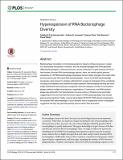| dc.contributor.author | Krishnamurthy, Siddharth R. | en_US |
| dc.contributor.author | Janowski, Andrew B. | en_US |
| dc.contributor.author | Zhao, Guoyan | en_US |
| dc.contributor.author | Barouch, Dan | en_US |
| dc.contributor.author | Wang, David | en_US |
| dc.date.accessioned | 2016-04-01T15:47:37Z | |
| dc.date.issued | 2016 | en_US |
| dc.identifier.citation | Krishnamurthy, Siddharth R., Andrew B. Janowski, Guoyan Zhao, Dan Barouch, and David Wang. 2016. “Hyperexpansion of RNA Bacteriophage Diversity.” PLoS Biology 14 (3): e1002409. doi:10.1371/journal.pbio.1002409. http://dx.doi.org/10.1371/journal.pbio.1002409. | en |
| dc.identifier.issn | 1544-9173 | en |
| dc.identifier.uri | http://nrs.harvard.edu/urn-3:HUL.InstRepos:26318550 | |
| dc.description.abstract | Bacteriophage modulation of microbial populations impacts critical processes in ocean, soil, and animal ecosystems. However, the role of bacteriophages with RNA genomes (RNA bacteriophages) in these processes is poorly understood, in part because of the limited number of known RNA bacteriophage species. Here, we identify partial genome sequences of 122 RNA bacteriophage phylotypes that are highly divergent from each other and from previously described RNA bacteriophages. These novel RNA bacteriophage sequences were present in samples collected from a range of ecological niches worldwide, including invertebrates and extreme microbial sediment, demonstrating that they are more widely distributed than previously recognized. Genomic analyses of these novel bacteriophages yielded multiple novel genome organizations. Furthermore, one RNA bacteriophage was detected in the transcriptome of a pure culture of Streptomyces avermitilis, suggesting for the first time that the known tropism of RNA bacteriophages may include gram-positive bacteria. Finally, reverse transcription PCR (RT-PCR)-based screening for two specific RNA bacteriophages in stool samples from a longitudinal cohort of macaques suggested that they are generally acutely present rather than persistent. | en |
| dc.language.iso | en_US | en |
| dc.publisher | Public Library of Science | en |
| dc.relation.isversionof | doi:10.1371/journal.pbio.1002409 | en |
| dc.relation.hasversion | http://www.ncbi.nlm.nih.gov/pmc/articles/PMC4807089/pdf/ | en |
| dash.license | LAA | en_US |
| dc.subject | Biology and Life Sciences | en |
| dc.subject | Genetics | en |
| dc.subject | Genomics | en |
| dc.subject | Microbial Genomics | en |
| dc.subject | Viral Genomics | en |
| dc.subject | Microbiology | en |
| dc.subject | Virology | en |
| dc.subject | Biology and life sciences | en |
| dc.subject | Molecular biology | en |
| dc.subject | Molecular biology techniques | en |
| dc.subject | Sequencing techniques | en |
| dc.subject | RNA sequencing | en |
| dc.subject | Molecular Biology | en |
| dc.subject | Molecular Biology Techniques | en |
| dc.subject | Sequencing Techniques | en |
| dc.subject | Sequence Analysis | en |
| dc.subject | Sequence Alignment | en |
| dc.subject | Organisms | en |
| dc.subject | Bacteria | en |
| dc.subject | Macromolecular structure analysis | en |
| dc.subject | RNA structure | en |
| dc.subject | RNA alignment | en |
| dc.subject | Biochemistry | en |
| dc.subject | Nucleic acids | en |
| dc.subject | RNA | en |
| dc.subject | Sequence Motif Analysis | en |
| dc.subject | Metagenomics | en |
| dc.subject | Marine Bacteria | en |
| dc.title | Hyperexpansion of RNA Bacteriophage Diversity | en |
| dc.type | Journal Article | en_US |
| dc.description.version | Version of Record | en |
| dc.relation.journal | PLoS Biology | en |
| dash.depositing.author | Barouch, Dan | en_US |
| dc.date.available | 2016-04-01T15:47:37Z | |
| dc.identifier.doi | 10.1371/journal.pbio.1002409 | * |
| dash.contributor.affiliated | Barouch, Dan | |


